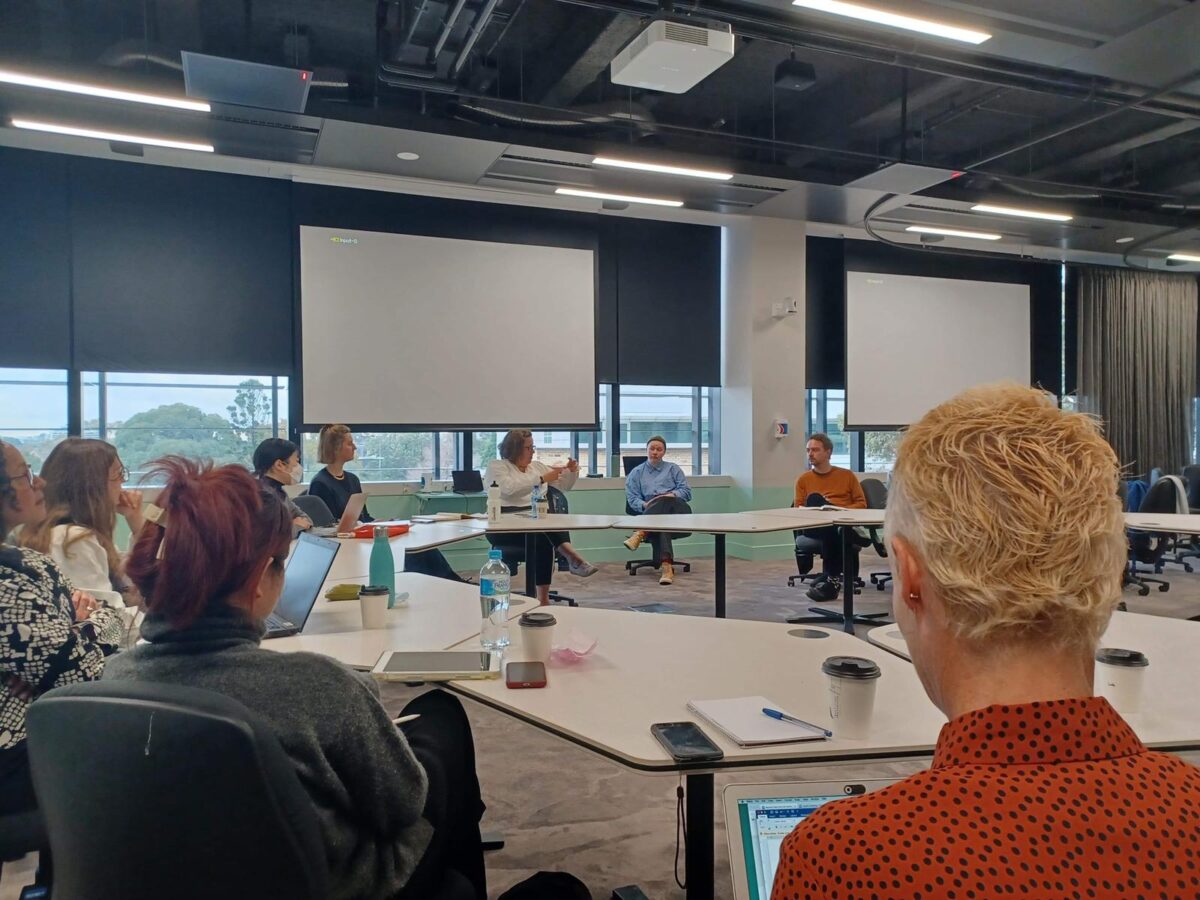
Louise Lawson Masterclass held at the University of Melbourne Arts West building in August 2022: Image Hayley Nolle
Louise Lawson, Head of Conservation at Tate, visited Melbourne in August 2022 as part of the ‘Precarious Movements: Choreography and the Museum’ research project. Tate is one of the project partners of the ARC-funded project, the other partners being the Art Gallery of New South Wales, Sydney; the Monash University Museum of Art, Melbourne; the National Gallery of Victoria, Melbourne; and UNSW Sydney. During her Melbourne visit, Louise sat down for an interview and delivered a masterclass to Grimwade Centre students and alumni about the conservation of performance. This article is based on both the interview and the masterclass discussions. The rest of the interview will be published on the University of Melbourne School of Historical and Philosophical Studies (SHAPS) forum and a link will be provided in the next AICCM E-news.
One of the main themes that emerged during the masterclass was the ways in which conservation of performance works differ from the conservation of static artworks. Performance works require more than textual and visual documentation alone. Louise shared her experience of developing a deeper understanding of performance artwork when it was activated, allowing the conservators to notice aspects of the work that were not previously articulated or documented. Unlike static artworks, performance works, like other time-based artworks, need to be activated for their care and documentation. Thus, it is important to acknowledge that the documentation, however comprehensive it might be, is not the work itself. The work inherently incorporates what Louise calls ‘a process of doing’ and an embodied form of knowledge that is distinct from textual knowledge.
Another key theme was the inherent variability of performance works and the need to respond creatively to this variability. For instance, Tate makes a point of developing conservation approaches that support the needs of an artwork, reflecting on existing processes. When deemed necessary, the conservation teams create new processes that best fit the work and its unique work-defining qualities. One example Louise provided to illustrate this point was ‘the family tree’, which charts performance works that require the transfer of embodied knowledge from one generation of performers to the next. The family tree structure allows the time-based media conservation team to monitor the robustness of the work’s network of performers and identify any potential vulnerabilities. This creative thinking mirrors the variability of the work itself and prioritises the integrity and care of the work over established patterns of working.
Tate Conservation devotes equal care to the shared institutional language used to document or discuss performance works. For instance, the team had long discussions about the word ‘iteration’, which is a common term that refers to an instance of the work’s display. They decided to use the word ‘activation’ instead of ‘iteration’ as, for the team, the latter felt it would create notions of repeating the work, while the former creates the space for the variability of the work to unfold each time it is performed. Similarly, the team uses the word ‘dormant’ for performance works that are not currently activated. The word dormant captures the sense that the work exists even though it may not have the materiality of an artwork that is in storage. Thus, the dormant status signals the work’s intangible presence and calls attention to the need to monitor and condition-check it at regular intervals just like any other work in the Tate Collection. Paying attention to the subtleties of terminology is another facet of the care and creativity performance works demand of conservators.
Performance works are growing exponentially in the collections of large-scale institutions. The Tate Collection is one that continues to grow, now holding close to 30 performance works. Louise suggests investing time into developing the thinking and guidelines for the care of performance works in preparation for their eventual acquisition is invaluable. The Tate time-based media conservation team generously shares its conservation strategy, tools and documentation templates for the care of performance artworks on Tate’s website. These resources are publicly available for collecting institutions to adapt according to their specific needs and to help them prepare for the acquisition of performance works in the future.
In developing guidelines, one area that requires special attention is the network of care provided to the artist, performers, and other people involved in a performance work (external producers, mediators, etc). Whilst there are detailed and widely established guidelines for the handling and display of traditional art objects, the same level of care needs to extend to performance. It is imperative from a conservation ethics point of view to invest time into articulating the care of the human body with the same level of attention we would devote to optimising the relative humidity, temperature and light conditions for the display of a traditional artwork.
Louise started the masterclass by sharing her own journey that led her to becoming a conservator. It was an inspiring story of tenacity, drive, and creativity. Performance works, which are growing exponentially in collections, demand these exact same qualities of tenacity, drive and creativity from us. Fortunately, networks of support exist across and within institutions to help conservators care for performance works and their wonderfully unique qualities.
The Masterclass was facilitated by Grimwade lecturer Dr Robert Lazarus Lane and organised by Master of Cultural Materials student Aslı Günel and SC@M with guidance from Lisa Mansfield, AGNSW time-based art conservator.
Connect with me on LinkedIn
or at by email
Aslı’s conservation research interests include the conservation of time-based art and working with communities to support the safeguarding of cultural heritage. Asl is currently writing her minor thesis on the creative and authorial agency of time-based media conservators.